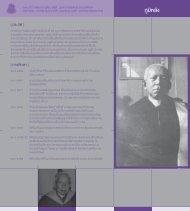You also want an ePaper? Increase the reach of your titles
YUMPU automatically turns print PDFs into web optimized ePapers that Google loves.
112Eusebioacross Southeast Asia and Taiwan are geared toward supporting ordisproving the hypotheses on the origins and dispersal of Austronesianspeakingpeople. The most mainstream among these hypotheses is the“Out of Taiwan” hypothesis, where the main proponent is PeterBellwood. According to this hypothesis, around 5500/6000 years ago, theproto-Austronesian speaking agriculturists from China migrated toTaiwan, and ~4000 years ago, the Austronesian-speaking people migratedfrom Taiwan to Island Southeast Asia. This hypothesis is part of the largerfarming/language dispersal hypothesis (Bellwood 2005). The geographicalscope of this hypothesis explains the geographical focus of this analysis.However, there is a notion that the Austronesian-speaking people alsomoved into the Mainland Southeast Asia (Malay Peninsula and Vietnam;Blust 1984-1985, as cited in Bellwood 1996), since at least two of theAustronesian languages are spoken in that area by two ethnic groups(Bellwood et al. 2006). Taiwan is crucial as the hypothetical origin of theAustronesian-speaking people (Bellwood 2005). Although its politicalaffiliation is East Asia, Bellwood (2005) included Taiwan in the IslandSoutheast Asia. These explain why researches from Mainland SoutheastAsia and Taiwan are also included in this analysis, aside from those inIsland Southeast Asia. Not everyone agrees with the Out of Taiwanhypotheses. The most popular alternative, where the main proponent isWilhelm Solheim II, is known as the “Nusantao Maritime Trading andCommunication Networks.” According to this hypothesis, theAustronesian-speaking people are called Nusantao and their homeland isin the islands of southern Philippines and eastern Indonesia (Solheim et al.2007).In relation to the discourse on the Austronesian expansion inSoutheast Asia during the Neolithic, the analyst wanted to track how thisissue was tackled in the last 15 years, from 1996-2010, in American Journalof Physical Anthropology, American Anthropologist, Current Anthropology,Molecular Biology and Evolution, and Antiquity. For the purpose of thispaper, the author of this paper is referred to as the “analyst,” not to beconfused with “author(s)” of works referred in the discussion. The focusis on articles discussing bioarchaeology, genetics, and material culture forexamining how the two subfields of anthropology, which arebioanthropology and archaeology, covered this issue. Aside from thethree leading American anthropology journals, two other journals thatcover the two subfields were chosen. Molecular Biology and Evolutionjournal covers genetics of not only humans but also of domesticatedplants and animals. Also, Antiquity has a worldwide coverage on



